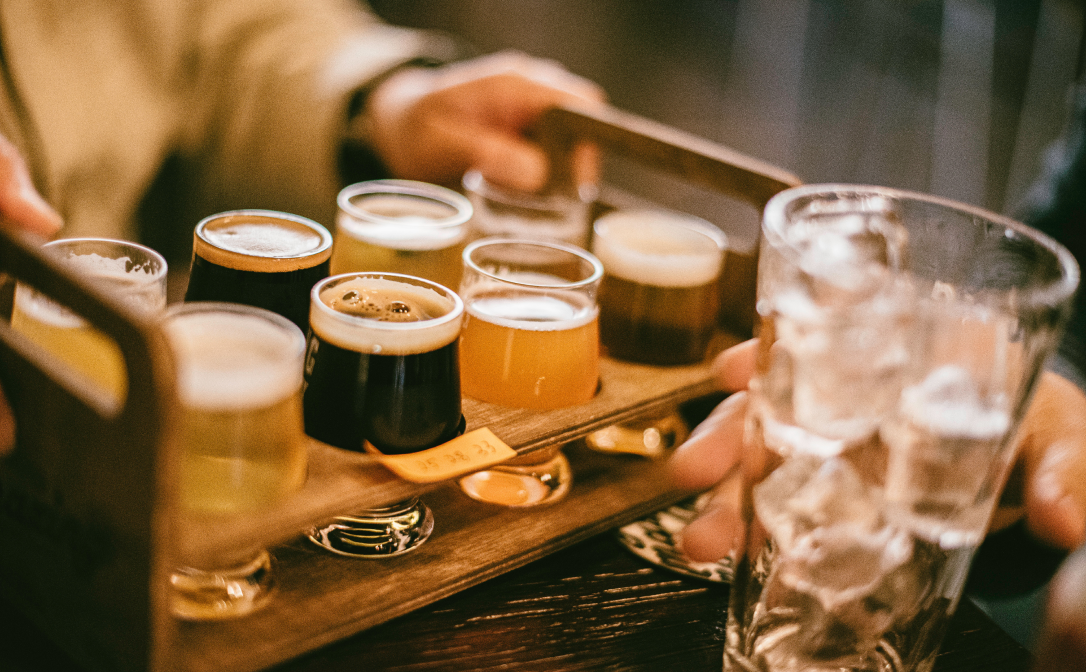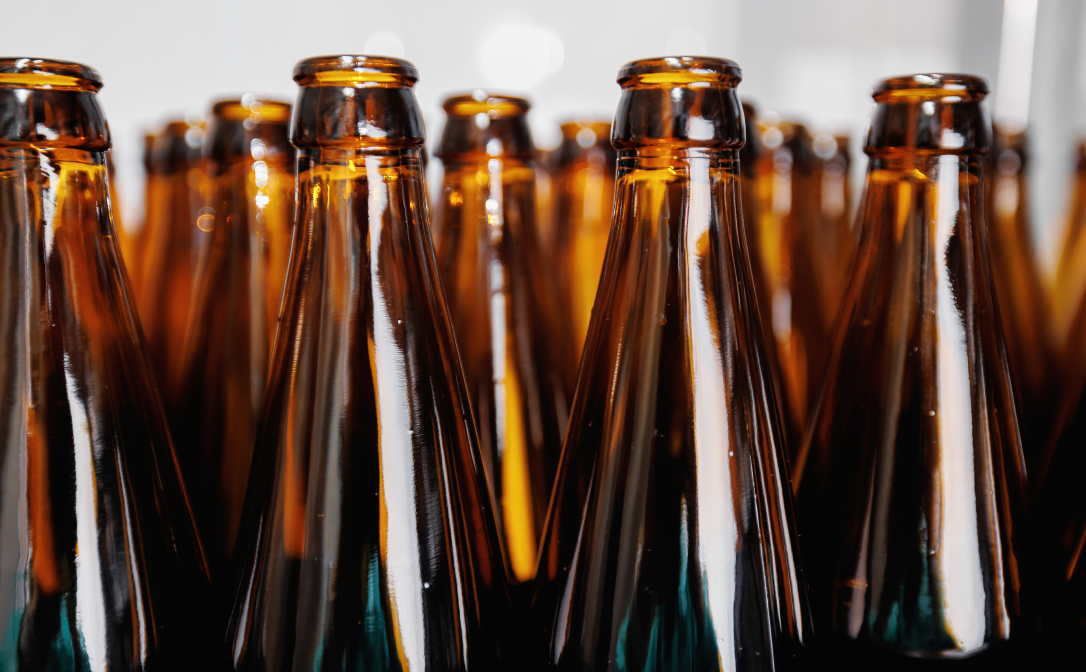In the not-too-distant past, beer was simply beer. Lagers ruled the globe, and quantity (lots) and cost (little) mattered more than quality and flavour. “Want something different? Try this light lager with a couple fewer calories.”
But upstart American brewers were dissatisfied with the status quo. Over the last five decades, U.S. brewers have paved flavourful new pathways for beer, treating generations of drinkers to a never-ending flavour trip.
Looking for a deep-dive into the world of beer? Click to find out more about WSET's Level 2 Award in Beer.
The more than 9,500 American craft breweries today produce a dizzying variety of beers, with no limit to what’s possible in a pint glass. From tropical IPAs reminiscent of fruity cocktails to tiramisu-inspired stouts and sour ales freighted with raspberries, every flavour and ingredient is fair game.
Creative high-quality craft beer is now broadly sold in supermarkets, convenience stores, sports stadiums, fine-dining restaurants, and even the rundown bodegas near my old Brooklyn apartment. Taprooms and production facilities now fill Main Street storefronts, former factories, and revamped warehouses, where breweries serve as a source of hometown pride, places to rally around like a local sports team, and root, root, root for the latest hazy IPA.
Welcome to the best time in human history to drink beer. But how did we arrive at this hop-filled moment?

A craft beer tasting flight
Prohibition created a clean slate for American brewing
The rise of craft beer first required the American brewing industry to go flat. As midnight welcomed January 17, 1920, the Volstead Act went into effect, ushering in a countrywide prohibition on alcohol, which dealt a death blow to many breweries. More than 1,300 breweries operated in America in 1916; when Prohibition ended, in 1933, just 331 produced beer, according to the Brewers Association trade group.
Survival required breweries to produce other pleasures. D.G. Yuengling & Son, which was founded in 1829, churned ice cream, while August Schell Brewing (1860) and Matt Brewing Company (1888) sold soft drinks. “They understood that if they wanted to stay competitive, they were going to have to make not just beer but beverages that non-alcoholic drinkers wanted,” Maureen Ogle wrote in Ambitious Brew: The Story of American Beer.
Other legacy brewing families endured thanks to additional financial assets. “What separated the companies that made it from the ones that didn’t is what they had to begin with at the start of Prohibition,” Ogle wrote. “The Pabst, Busch and Miller families had all invested in real estate holdings.”
Breweries exited Prohibition and entered the Great Depression, as well as the Dust Bowl and World War II, both of which made ingredients scarce. After reaching a post-Prohibition height of 857 breweries in 1941, breweries closed or consolidated. Tastes changed with the times. Increasingly, lagers contained greater percentages of rice, mimicking the mild, less hoppy Western lagers that were popular on the West Coast.
Rice helped create crisp, light, thirst-quenching lagers that appealed to a wide swath of consumers, paving the way to the rise of advertising-driven national brands such as Schlitz, Hamm’s, and Budweiser. The die was cast for American lager dominance. By 1978, just 89 breweries operated in America. Advertising, brand-building, and market share mattered more than flavour. The national breweries were locked into the so-called “light beer wars.”
The wildfire success of Miller Lite, which Miller Brewing took national in 1975, led Anheuser-Busch to respond with Natural Light, Michelob Light, and Bud Light, which debuted in 1982. The light beers shone so bright that they largely overshadowed a quiet revolution for better beer.
The birth of craft beer
Craft beer’s modern roots stretch to 1965 when washing-machine heir Fritz Maytag bought San Francisco’s failing Anchor Brewing and reformulated the recipe for Anchor Steam. In 1976, Jack McAuliffe debuted Sonoma, California’s short-lived but influential New Albion Brewing Company, widely considered to be the country’s first microbrewery.
The grassroots movement gained further traction on February 1, 1979, when President Jimmy Carter’s bill legalizing homebrewing went into effect. Amateur brewers became entrepreneurial. In Chico, California, homebrew shop owner Ken Grossman cobbled a brewery from dairy tanks and equipment from defunct breweries to open Sierra Nevada Brewing Company in 1980, introducing the floral, grapefruit-scented, and Cascade hop–driven Pale Ale the following year.
“Our plan for Sierra Nevada beer had always been to emphasize hops and their delightfully piney, citrusy, bitter flavor,” Grossman wrote in Beyond the Pale.
In 1981, Starbucks cofounder Gordon Bowker co-founded Redhook Ale Brewery inside a Seattle transmission shop. By 1984, Jim Koch co-founded the Boston Beer Company, which produced Samuel Adams Boston Lager. “It was a long, slow process of growth—very much like fermentation,” Koch has told me of the early days.
These small-batch beers were bottled in brown glass, a visual departure from imported beer’s favored green glass and domestic lager’s aluminum cans. These upstart breweries were collectively called microbrewers, a term coined by a computer-industry worker who moonlighted at influential homebrewing magazine Zymurgy. “He said, ‘You know, these small breweries are kind of like microcomputers,’” Charlie Papazian, the author of The Complete Joy of Home Brewing, has said.
“Micro” is an ideal adjective in the tech industry, where outsize power is derived from ever-smaller chips. But microbreweries were growing bigger. In a 1987 New Brewer article, Papazian classified a craft brewery as one that used “the manual arts and skills of a brewer to create its products.”
Craft brewery. That has a nice ring.

The typical brown glass bottles used for craft beer
In the early to mid-’90s, craft breweries mushroomed nationwide, and breweries including Pyramid, Pete’s Brewing, Widmer Brothers, Brooklyn Brewery, and Deschutes Brewery brought stouts, brown ales, wheat beers, and pale ales to broader audiences. Not wanting to miss out on market share, the major breweries rolled out “craft” brands like Red Dog, Red Wolf, and Killian’s Red. A glut of middling beers and slowing sales led to a brutal shakeout in the late 1990s.
“People who didn’t have a passion for being in the business dropped out,” Koch says. “It shook away the brewers who were not making very good beer.”
Resilient craft brewers doubled down on innovation. In the early 21st century, American craft breweries began making waves for boldly flavoured, experimental beers. Dogfish Head turned out culinary-inspired creations like Raison D’Etre, made with green raisins and beet sugar, or the beer-mead-wine hybrid Midas Touch that is based on ingredients found in 2,700-year-old drinking vessels in King Midas’s tomb.
On the West Coast, the Southern California breweries Stone, Green Flash, and Ballast Point reconfigured England’s bitter, malt-rich India pale ale as a dry, piney, and citrusy blast of sunshine. The West Coast IPA, as it was called, gave rise to the stronger and often super-bitter double IPA.
Russian River Brewing, in California, inoculated ales with the wild yeast Brettanomyces and souring bacterial Lactobacillus, which impart funky flavors. Goose Island started aging its potent imperial stouts in bourbon barrels, creating Bourbon County Brand Stout and a craze for barrel-aging strong stouts and barley wines. Craft beer became synonymous with extremes in alcohol and flavour.
American IPAs inspire the globe
By 2010, America contained more than 1,800 breweries, and their rule-breaking approach began inspiring breweries in the U.K., Norway, New Zealand, Argentina, Japan, and every continent except for Antarctica to produce unique beers. In America, the 2010s marked the rapid proliferation of craft breweries, fueled in part by the evolution of IPAs.
While IPAs grew in popularity thanks to their bold, bitter flavours and booziness, aggressiveness proved off-putting for too many drinkers. Think about espresso. Many people enjoy the strong, concentrated coffee as a cappuccino or latté that minimizes bitterness.
Breweries in the Northeast, such as Hill Farmstead, the Alchemist, and Tree House began producing smooth, barely bitter hazy IPAs featuring fruity, tropical flavours and aromas of new hop varieties such as Citra and Mosaic. Customers clamored for these beers, queuing for hours at breweries like Bissell Brothers in Portland, Maine, and Monkish, located near Los Angeles, to buy freshly canned four-packs of hazy IPAs that tasted like orange juice and other beloved beverages. Everyone could find an IPA to love.
“We have a unique ability to bring in people that aren’t currently craft drinkers,” Dave Knospe, the vice president of marketing for New Belgium, has said.
Creating beers that evoke familiar drinks and foods became a reliable way to attract a wider audience, leading to dessert-inspired pastry stouts and sour ales. These rich beers take inspiration from ice cream, candy bars, and other sweet treats of every persuasion, brimming with nostalgia and pleasure.
“You’re appealing to the simplest sense of desire and everything you remember being extra-decadent when you were a kid,” Matt Monahan, a cofounder and the CEO of Other Half, has said.
Craft beer is no longer the new kid on the tap. After years of breakneck growth, sales are decelerating, and closures and consolidations are becoming more commonplace. These are signs of a maturing and evolving industry, one facing competition from hard seltzer, hard tea, THC, canned cocktails, spirits, and declining rates of alcohol consumption.
Craft brewers, though, are an adaptive breed, nimbly responding to shifting trends and consumer desires. Inventive breweries are in the business of delivering flavor in all liquid form factors, be it a non-alcoholic IPA, THC-infused seltzer, or even a light lager that goes heavy on flavour. Craft breweries have already made their mark on the present. Don’t count them out to ferment a flavourful future too.
This blog post was written by Joshua M. Bernstein, an award-winning author and journalist. Since 2000, he has written for scores of newspapers, magazines and websites, including The New York Times, Wall Street Journal, The Atlantic, VinePair, Wine Enthusiast, and Imbibe, where he’s a contributing editor in charge of beer coverage. He is also the author of six books, including Brewed Awakening, his deeply reported take on the global craft beer revolution, and The Complete Beer Course. The totally revised and updated edition of The Complete Beer Course was released in June 2023.


